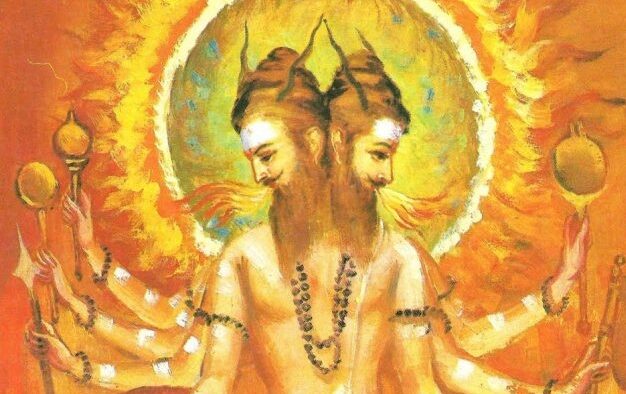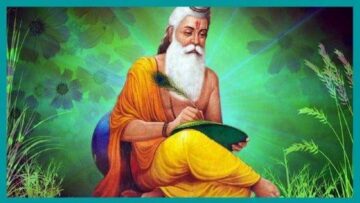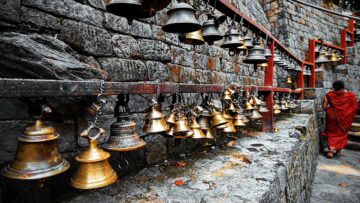Anyone acquainted with Hinduism – whether a Hindu or non-Hindu also knows about Puranas. The very name indicates that it is about something old. Athrvaveda mentions the term and in Brahmanas Puranic literature is mentioned while Upanishads call ‘Itihasa-Purana’ the fifth Veda. P.V. Kane opines that various references make it obvious that from the later Vedic age works called Puranas existed that were studied and recited by those that were engaged in solemn sacrifices like the Asvamedha and that by the time of Apastamba and Gautama, some versions of the extant Puranas had come into existence. The antiquity of the Purana literature thus cannot be doubted, even if all the Puranas has not survived and many of the extant ones are of later provenance. Yet though they are sacred literature they rank lower in the hierarchy of scriptures than Vedas. Aside from other reasons, one cause probably was due to the social class of the readers and target audience of the Puranas. They were open to lower castes and women to listen to and learn from. As civilization became increasingly complex the Brahmins insisted on being the sole interpreters of the most revered scriptures, though nothing prevents a Brahmin from storing up punya by reciting or listening to a Purana. However if the Vedas are reserved for a priestly class only, then the Puranas are for the masses. As such they are far more popular and well known. For probably the same reason whereas the Vedas number only four, ( or from a traditional perspective one Veda that has been divided into four parts) , through the centuries several Puranas have come into existence. Through constant interaction with society, a purana becomes a living entity so that we cannot say that one version is true and another false. In this context, when we study the Puranas as a scholar, as distinct from being a believer in their sacredness, an important question is what the composers/compilers of the texts thought about their work and how the Puranas projected themselves.
The Puranas accepted superior authority of Vedas and consequently do not contradict them in any way. Yet if they were just a simplified version of the latter, they would hardly have appealed to a wider group. Instead, they also saw themselves as storehouses of knowledge. The self-proclaimed purpose of these texts was to dispense divine wisdom, simplified salvation for masses, and history. So they tell us stories, both sacred and secular, of the gods and the kings. Interwoven in between the stories are descriptions of geography, ceremonies, duties of kings and householders, the ideals of varna-ashrama, land grants, temple-architecture et al. Of course any compilation of such knowledge cannot be considered a Purana. As per the Puranas themselves and Amarkosa, any work that desired to be classed as a purana had to conform to a certain formula of Panch-lakshanas, or discussion of five topics: Sarga / original creation of the world; Pratisarga / dissolution and recreation; Manvantaras / the periods of the various Manus; Vamsha / the genealogies of gods and rishis; Vamsanucharita / account of royal dynasties including the Suryavamshi and Chandravamshi kings. Those five topics were necessary to present an assurance of continuity to the audience, specially of the royal genealogies which are now only a memory but can be claimed as progenitors by later day rulers. If we look at the 18 MahaPuranas we find that while they have the Panch-lakshanas in common, each of them is also different expanding their range beyond them. For example, Bramhapurana discusses the art of war and temples, Garudapurana discusses literature and yoga and astronomy and minerels and stones, while Bhagavatapurana, Lingapurana and Markandeyapurana are the central religious texts of Vaishnavism, Shaivism and Shaktism respectively. Thus every purana is an autonomous text distinct from others of the genre. This is how they frame themselves – as keepers of ancient wisdom and guides to dharma which gives same liberation to ordinary men as Vedas can.
Agni-Purana too frames itself in such terms. The first question that arises is what authority does it claim? The simple answer is that it is composed/ recited by VedaVyasa. Since Vyasa divided the Vedas into four parts and taught them to four disciples, this grants gravitas to the text. However, he is also understood to be the author of every other purana at some point in the line, and of course he is the author of Mahabharata. So while he validates the claim of authority, he alone is not sufficient. So the chain of transmission is traced further back. The first narration is by the God of Fire which makes the knowledge contained therein divine, therefore true. He told it to Vasistha who re-told it to Vyasa and Vyasa then imparted it to others including the suta who is the immediate reciter of the purana for edification of the world. It is interesting to note that though Agni tells it, it is not about the god at all. Instead he emphasizes worship of another major deity, a trait that is to be found in other puranas also. But this makes the material even more ‘true’, since the divine narrator is not self-aggrandizing. Agni narrates the Purana to Vasistha, one of the saptarishis who authored verses in Vedas. Then Vasistha retells what he has heard to Vyasa. Vyasa repeats it to the suta who narrates it to us the readers. The line of sages connected to Vedic lore makes the transmitted knowledge trustworthy: it is impossible for such people to forget or mislead. The same argument applies to the suta since by his profession he is incapable of mis-stating the lore he had acquired. In the last chapter we learn that the original source is even more glorious: it is Vishnu who in the form of destructive fire at the end of the world taught this knowledge to Agni. Such a narrative framework is central to Agni-Purana positioning itself as a storehouse of divine knowledge, specially since it is actually a late composition. Critics argue that the extant Agni-Purana is spurious and either the original Agneyapurana mentioned in other sacred literature has disappeared or as per H. C. Hazra the genuine text saved itself by assuming the different title of Vahnipurana. However, when situated within its own genre, surely it does not matter whether a Purana was composed/compiled thousands of years ago or just a few centuries. As stated before, the contents are common property, not copyright. It is thus ‘authentically’ antique because its knowledge came from gods to sages sealed with Vyasa’s place as narrator via transmission. The present text of Agni-Purana therefore can project itself to be as authentic as the Vedas themselves.
Agni-Purana is slightly different from other Puranas in that it projects itself as an encyclopaedia of all branches of knowledge in the known world. The subject matter, we are told are of two kinds of knowledge, the para and the apara. The pancha-laksmanas are also present in detail prefaced with the statement that Vishnu is their source. But it is this distinction of the two types of knowledge that makes the Purana interesting. Vasistha desires to gain knowledge of how he can cross the ocean of mundane existence, by knowing the quintessence of which knowledge one becomes omniscient. Usually such question evokes response of spiritual knowledge. However Agni ranges further. He will impart para-vidya or superior knowledge that is knowledge of Brahman, which is what Vasistha actually wanted to know. Included in it are the stories of various avatars of Vishnu including Buddha and the future Kalki. But he will also impart knowledge about aparavidya or inferior knowledge. They consist of: “Rigveda, Yajurveda, Samaveda, Atharvaveda, the six supplementary texts, (namely) — Siksha , Kalpa , Vyakarana, Nirukta , the movement of the luminary bodies, Chandovidhana, Mimansa, DharmaSastra, Puranas , Nyaya, Vaidya, Gandharva , and Arthasastra.” In other words, all the schools of study that were current at that time and had known texts of their own will be discussed as well besides theology.
Again, though at the beginning Agni and Vasistha names those systems, they are not interpreted rigidly. Rather they run through a gamut of topics. They include building cities, duties associated the different Varnas, statecraft, ideal behaviour of a king, royal advisors, justice system, family law, warfare, everyday actions, poetics, list of Sanskrit dramas, how actors should perform, sentiments and emotions associated with acting and even a lexicon. The god thus intends to teach secular knowledge even though it has not been asked for. This is not surprising since the ultimate target audience is not actually the wise sages but the laity comprising of kings, nobility, administrators and ordinary people who need such knowledge in their everyday social life, in work and leisure.
Nor are ‘inferior’ religious topics neglected — we get instructions for religious bathing, construction of a Kunda, the Mudras, the mode of worship of various deities, mantras, consecration of an image, architecture of a temple, repair of a temple, iconography of the images, manifestations of Devi , tirthas, rites for ancestors, religious gifts, penances for various sins, pollutions and purifications, list of puranas and gifts to be given when they are being recited. Instead of elaborating a few topics, all possible ones required for daily functioning of society has been presented chapter wise in condensed form. As a result, all cultural facets that are usually considered the province of the elite intellectual classes became free for everyone to consult. One doesn’t have to know ‘Vedic mathematics ‘to construct altars, he can simply consult Agni-Purana.
Agni-Purana frames itself as the foremost of all Puranas through the promised reward of learning the entire text. Listening to it is more meritorious than gift-giving, sacrificial rites, pilgrimages etc. Anyone reciting or hearing the text or causing it to be written and recited would be free from all sins and gain moksha. It thus empowers the hearers and speakers alike. But as we have seen, secular knowledge has also been incorporated and its rewards are correspondingly material. By reading it, worldly misfortunes can be averted. A Brahmin would gain knowledge of Vedas, a kshatriya kingship, a Vaishya wealth and a Sudra health. A copy of the Agni-Purana in a house prevents difficulties, theft, miscarriages there. Those who desire wealth would gain a fortune, those progeny would have children, those power would be kings. A question might be raised as to why such mundane things are given importance. The probable answer is Grihastha or householder is central to the social order and upholds the cosmic order as well – therefore they need to learn such things as well as liberation and they must be given inducements to obey the dictums. Vasistha justifies tying the transcendent with the mundane by declaring that in order to understand Hari properly and get liberation all knowledge must be known, including what would be considered as profane. Thus, a man who listens to it is promised both full enjoyment of this world as well as final release from it. After all, nothing else is needed in life and so Agni-Purana becomes the ultimate knowledge-system of society.
Agni-Purana thus popularised the teachings of various branches of study, both metaphysical and mundane. That is why Agni tells Vasistha that this purana will bring both bhakti and mukti. A listener can rely on the text to provide him with whatever he needs to the exclusion of other texts. Through doing this, it becomes the source of all dharmas one can find in society and afterworld. It is therefore reasonable to conclude that Agni Purana presents itself as a complete tool-kit of civilization and that is how we must understand it.
(This paper was presented as a part of a Conference on Puranas and Indic Knowledge Systems, organized by Indic Academy on 26th and 27th March 2021.)
Featured Image Credit: detechter.com
Disclaimer: The opinions expressed in this article belong to the author. Indic Today is neither responsible nor liable for the accuracy, completeness, suitability, or validity of any information in the article.









